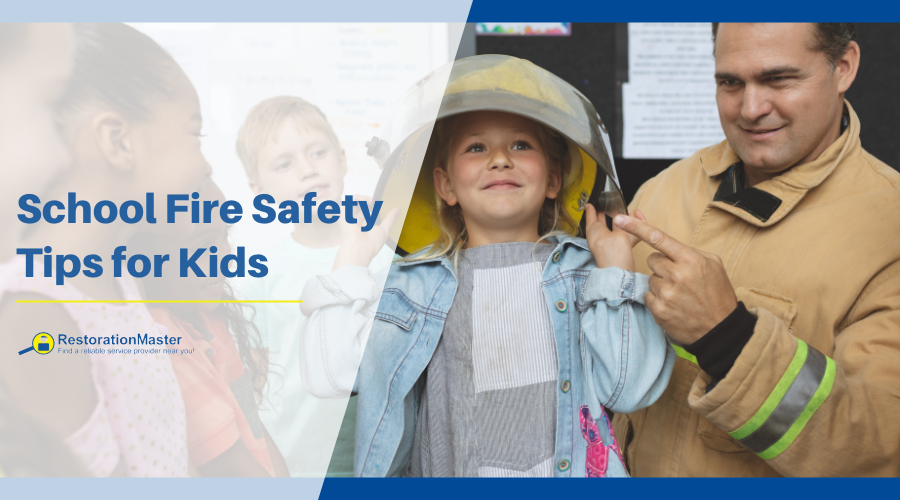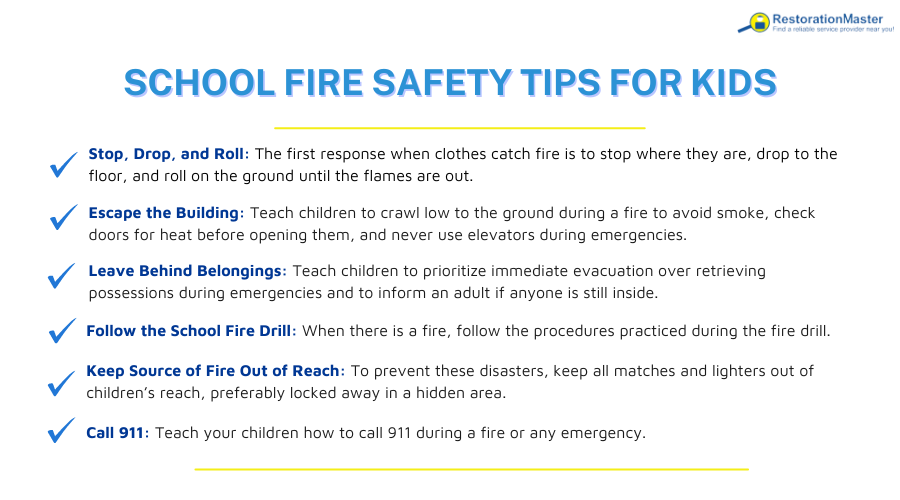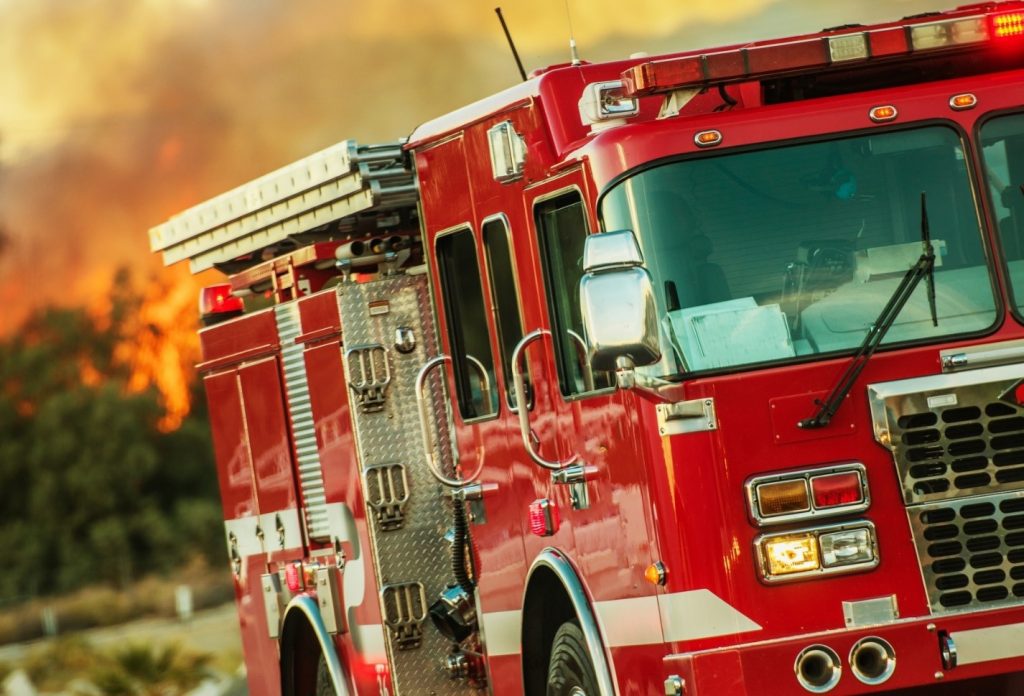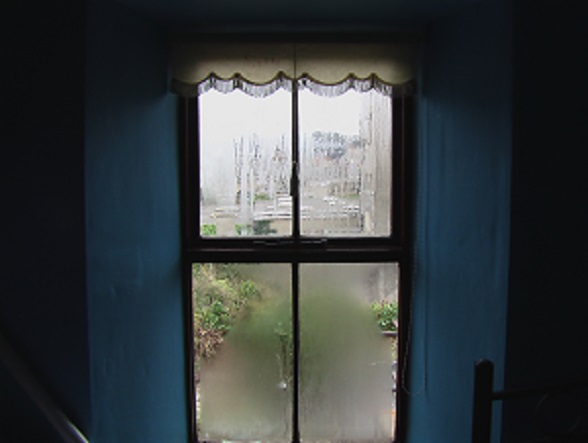School Fire Safety Tips for Kids

School is back in session and with so much going on, it can be easy to forget about priority safety measures like fire safety guidelines. As parents and teachers, it’s our job to teach and remind kids about the importance of fire safety. These kids are the future generation and must be taught the importance of preventing fires and protecting the well-being of everyone in school.
Be sure to review and practice these school fire safety tips with your kids to prevent any disasters, injuries, and other emergencies:
1. Stop, Drop, and Roll
To think of your clothes catching on fire is terrifying. The instinctual reaction for kids will be to run but panicking in this situation will only make matters worse as they will only be fanning the flames. The first response when clothes catch fire is to stop where they are, drop to the floor, and roll on the ground until the flames are out.
Let kids know that this practice smothers the flames and prevents air from reaching them. Ensure to practice this technique with them so they are familiar with what to do when the time comes.
2. Escape the Building
The smoke can be just as dangerous as the flames when trapped inside a building with a fire. In order to breathe, you need clean air, and inhaling smoke can be very dangerous. Educate children on how smoke rises, so the fresh air will always be closest to the ground. This is why kids should always be taught to crawl on their hands and knees when evacuating a burning building.
When approaching a closed door, they should never reach up and turn the handle as the fire may be on the other side. To ensure the other side is safe, feel the door with the back of your hand. If it’s warm, find another way out. If it’s cool, proceed to opening the door and crawl through, remaining low to the floor on the way out.
Kids should also know to never use the elevator as they can malfunction and trap kids inside during emergencies. If there is anyone trapped inside the elevator, tell them to inform an adult immediately.
3. Leave Behind Belongings
Many kids are attached to their possessions, like phones, especially at school because their items can be comforting to them. But they must know that sacrificing any time during an emergency to find them can be lethal.
Teach children that the first priority in any emergency is to evacuate the building immediately. If anyone is still in the building, they must inform an adult immediately.
4. Follow the School Fire Drill
If your child is unsure of what to do in the event of a fire drill, explain all of the tips on what to do:
- Teachers will let their students know that the fire drill will occur during the day.
- At the time of the drill, the fire alarm will go off, and all students must listen to given directions.
- Line up quickly, following the teacher outside.
- Stay with the class at all times and be present during roll call and head counts.
- Wait for the signal saying that everything is “all clear” and they can re-enter the classroom with the teacher and other students.
5. Keep Source of Fire Out of Reach
Painstakingly, children accidentally start about 50,000 fires each year in the United States, leading to around 11,000 building fires. To prevent these disasters, keep all matches and lighters out of children’s reach, preferably locked away in a hidden area. Teach your kids about the dangers of playing with fire and how everyone’s safety is put to risk when flames are not handled carefully.
6. Call 911
Teach your children how to call 911 during a fire or any emergency. If a building is on fire, a crime has been committed, or someone is having a medical emergency, the authorities can be contacted and will know how to proceed.
Also teach children that calling 911 should never be used as a prank, as it puts everyone else at risk.

Everyday School Fire Safety Tips
Ensuring fire safety in schools is not solely the responsibility of the administration; it requires a collaborative effort from teachers, students, and parents. By incorporating fire safety into the everyday school routine, everyone can contribute to a safer environment. Here are some practical tips that can be easily integrated into the daily life of schools:
Avoiding Overcrowding in Classrooms
Classroom overcrowding can pose serious risks during a fire emergency, as it can hinder evacuation efforts. Teachers should ensure that classrooms remain within capacity limits to facilitate easy movement in case of an emergency. It’s essential for students to understand the importance of maintaining personal space, especially during fire drills or emergencies.
Maintaining Clear Hallways
Maintaining clear hallways is a critical aspect of ensuring safety within school environments. Hallways serve as vital pathways for students and staff during everyday activities and emergencies alike. When emergencies occur, such as a fire, unobstructed hallways can make the difference between a quick, safe evacuation and a chaotic situation that could jeopardize lives.
Conducting Regular Safety Inspections
To ensure hallways remain clear, it’s important for everyone in the school community to take responsibility. Teachers should remind students to keep their backpacks and personal items in designated areas rather than in the middle of aisles. Schools can implement routines to regularly check hallways for clutter, encouraging both students and staff to participate.
Regular Practice of Escape Routes
One of the most crucial aspects of fire safety in schools is familiarizing students with escape routes. Regular practice of these routes ensures that students know exactly where to go in case of a fire emergency. Here are some guidelines to effectively implement practice drills and reinforce knowledge of escape routes:
- Regular Fire Drills: Schools should conduct fire drills at least twice a year, and it’s beneficial to rotate the days and times to simulate various scenarios. These drills will help students understand the urgency of evacuating quickly and safely.
- Clear Signage: Ensure that escape routes are well-marked with visible signage. Students should know that green “exit” signs leadLead is a heavy metal that can be toxic to humans, especiall... More to safety, and they should be encouraged to look for these signs during drills.
- Classroom Discussions: Teachers can hold discussions about the importance of knowing escape routes and what to do in different emergency situations. Engaging students in these conversations will help demystify the process and reduce anxiety during real emergencies.
- Buddy System: Pairing students up during drills can create a sense of responsibility and teamwork. Each student can look out for their buddy, making sure they stay together throughout the evacuation process. This approach not only promotes safety but also helps younger or less confident students feel reassured.
- Walk-Throughs for New Students: At the beginning of each school year, new students should receive a dedicated walk-through of the school, including key emergency exits and safe meeting points. This can be woven into the orientation sessions, ensuring that new students understand the school’s emergency protocols from day one.
Dealing with Fire Damage
Evacuating all teachers, students, and staff during a fire is imperative and should be considered the first priority in the event of a fire. After doing roll call, immediate action must be taken to extinguish the flames, which is why it’s important to call the fire department right away.
Once the flames have been extinguished, it can be traumatic to discover the amount of damage that has left the building in critical condition. Efforts should be taken right away to restore the building from fire damage as the smoke produced from the flames is still permeating throughout the halls and classrooms. Don’t hesitate to call a local fire damage restoration company immediately after the fire department has extinguished the flames.

After doing a roll call, immediate action must be taken to extinguish the fire flames.
Fire Damage Restoration
As the damage can still spread days after a fire, a fire damage restoration contractor must be called right away to restore the damage. Many are available 24/7 and will respond immediately with professional equipment and products to provide repairs, clean out the smoke and sootSoot is fine black particles composed of carbon and other ma... More byproducts, and restore contents within the school like desks, school materials, chairs, computers, and other valuables.
Licensed and trained technicians will first address high priority tasks like boarding up windows and doors and stabilizing the building. They will then move forward to prevent the damage from spreading any further. After cleaning the smoke and sootSoot is fine black particles composed of carbon and other ma... More from the property structureStructure refers to the framework or components of a buildin... More, any odors within porousPorous describes a material that contains small openings or ... More materials will be removed using professional deodorizers.
After the restorationRestoration is the process of returning a property to its pr... More project, you can be sure that the school will provide a safe learning environment for all students again, allowing them to safely return to school after minimal interruption.












